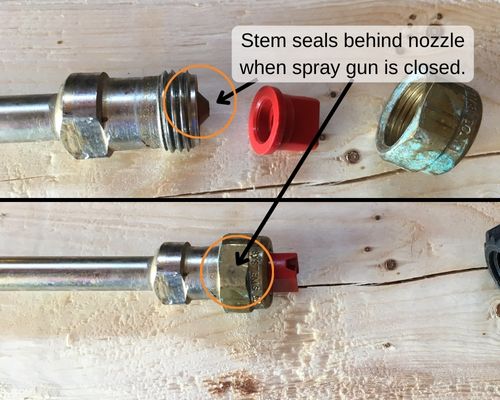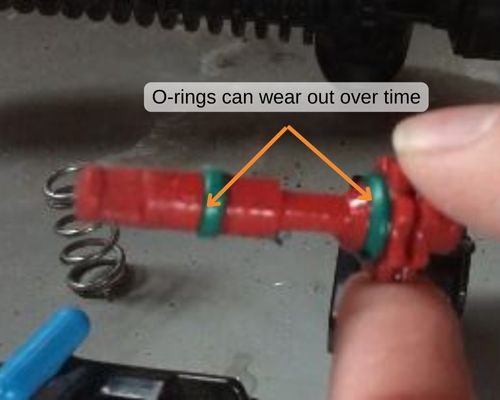Lawn sprayers are effective when they help your pesticide reach its intended target. However, when they don’t stop spraying, they create a real mess. Not to mention a potential hazard to you as well as other people, plants, or animals.
So what can be done? Well, I have been there before, and I want to share the things that worked for me. First, let’s jump into the quick ways to fix your sprayer when it fails to shut off, and then we will discuss each one in greater detail.
Quick Fixes for Lawn Sprayer That Won’t Stop Spraying
- Rinse out the sprayer gun with fresh water
- Take the spray gun apart and clean it thoroughly
- Check the spring and diaphragm/plunger in the valve assembly for damage
- Add a check valve to the spray wand
If you have other issues with your lawn sprayer, be sure to refer to these guides for more troubleshooting help:
- Hand Pump Sprayer Troubleshooting Guide
- Backpack Sprayer Troubleshooting Guide
- 12-Volt & Spot Sprayer Troubleshooting
Understanding Why Your Sprayer Won’t Shut Off
Understanding how your specific spray wand functions is key to solving the issue. Typically the main reason why your lawn sprayer won’t shut off or stop dripping is because there is a malfunction somewhere inside the trigger wand.
Obviously, the trigger wand is the sprayer component that you hold in your hand and use to direct spray. While there are many different types of spray wands, they are all similar in their construction. The basic parts are the handle, trigger, wand extension, and nozzle.

Although Most spray wands are very similar the differences can affect what you need to do to fix the issue.
The basic poly or plastic sprayer wands have a valve assembly that is inside the handle. When you pull the trigger it opens and allows fluid to pass through. When you let go it seals up, stopping the liquid from continuing to spray. In these versions, any liquid still in the wand extension will still be sprayed out of the nozzle after the valve closes.
Some spray wands, like TeeJet’s “no drip” GunJet, have a rod that runs the length of the spray wand extension and seals right behind the spray nozzle when the trigger is not pulled. These sprayer wands provide a much quicker response, in other words, when you release the trigger spray stops almost immediately.

How to Fix a Sprayer That Won’t Stop Spraying
Let’s get into the specifics of fixing each of the common issues that will cause a sprayer to fail to stop spraying or shut off.
Clean the Spray Gun
One of the most common problems associated with a sprayer’s failure to shut off is chemical residue and grime clogging up the trigger valve. Unlike water, it is the nature of many pesticides and fertilizers to leave behind residue when they dry.
Over time this can build up enough that the valve won’t seal up properly. This means liquid continues to exit your nozzle as long as there is pressure in the tank of your sprayer.
Here is how to thoroughly clean your spray gun:
- Locate the valve assembly in your spray wand. (Some are in the handle, some seal at the area where the extension wand attaches, see video below.)
- Disassemble the wand so you can access the internal valve components
- Remove the spring, plunger, stem, diaphragm, etc. All of the valve components.
- Use soapy water, and scrub each item gently. Soad in soapy water if needed.
- Use a soft brush to scrub inside the sprayer handle
- Flush and rinse everything with fresh water
- Reassemble the valve and test
If you have a “drip-free” spray wand, be sure to thoroughly clean behind the spray nozzle where the valve closes. For more details, take a look at the repair instructions for a drip-free sprayer gun.
Check for Broken Pieces in the Valve Assembly
Inside the trigger wand, several individual components make up the shut-off assembly. These are the parts that stop flow when you release the trigger on the spray wand. Typically there is a rod or stem, spring, and packing or diaphragm.

If any of these pieces are damaged, then the valve will not work. Most of these items will not be easily repaired. Fortunately, many spray gun manufacturers offer a repair kit for their wands.
Spray Wand Repair Kits:
| Spray Wand Mfg | Spray Wand Model | Repair Kit # |
| TeeJet | AA30L-22425 | ab30L-kit |
| TeeJet | 22670 | PK-AB22670-PP-KIT |
| Solo | Solo 4900170N 28-Inch Universal Sprayer Wand | 0610402-K |
| Chapin | Chapin International 6-8138 Shut-Off Assembly | 6-8120B |
Replace Packing/Diaphragm
What if you take apart the spray one valve assembly and there do not appear to be any broken pieces? You clean everything thoroughly, put it back together and it still won’t shut off.
If this is the case, you can try to change the diaphragm/packing in the valve.
The diaphragm is the portion of the valve assembly that provides the seal to prevent liquid from exiting the wand. In some spray wands, it may be a packing or other type of seal.
Even if everything appears to be OK, the diaphragm may not be able to seal up any longer. Chemicals can break down the resilience of the diaphragm, making it unable to keep its shape.
Replacing the diaphragm is your only option. Typically this will be included in the repair kit, if there is one available for your spray wand.
How to Take Apart a Lawn and Garden Sprayer Wand
You can’t fix your sprayer wand if you can’t get it open. Some spray wands make it easy. For instance, on a Solo sprayer wand, You simply pull out the pin that holds the handle in place and then you can unscrew a cap to remove the old valve shut-off assembly.
Add a Check Valve to The Spray Wand
The other main aspect of any sprayer wand is the nozzle assembly. Your spray nozzle may drip when you let go of the trigger on the spray wand because there’s still fluid inside of the wand extension. The valve closes inside the handle, so all the liquid still inside the extension will run out of the spray nozzle even when it is closed.
If you want to avoid all of this extra liquid dripping out after you close the wand, you can add a check valve to the end of the wand extension.
This check valve will shut when the pressure inside the sprayer drops below a certain level. So when you let go of the trigger wand, the check valve closes and eliminates any more liquid leaking from the nozzle.
However, one thing to consider is the cracking pressure of the check valve. All check valves close at a certain pressure. There are different cracking pressures available: 5, 10, 15 psi, etc.
So while a check valve can stop the leaks, it also means that you will have to pump your sprayer up and keep it above the cracking pressure of the check valve to spray. If you have a battery-powered sprayer this may not be an issue. However, with manual backpack sprayers or hand pump sprayers, this can lead to a lot more physical work.
For detailed instructions, see this post on stopping spray nozzles from dripping
The other option is to use a spray gun that closes immediately behind the sprayer nozzle. I referenced this type of sprayer gun above, The TeeJet 30 spray gun is considered a “drip-free” spray wand. This is what I use to avoid waste and chemicals dripping all over my truck or ATV when I spot spray.
The trigger operates a stem that runs the length of the wand extension. The end of the stem seals right behind the nozzle when the trigger is not pulled. Liquid will stop exiting the nozzle as soon as you let off the trigger
Conclusion
When a lawn sprayer won’t stop spraying it can be more than just an inconvenience; it can pose a real hazard to you, your plants, and animals. However, by understanding the underlying causes and taking practical steps to address them, you can quickly return your lawn sprayer to its optimal functioning state.

